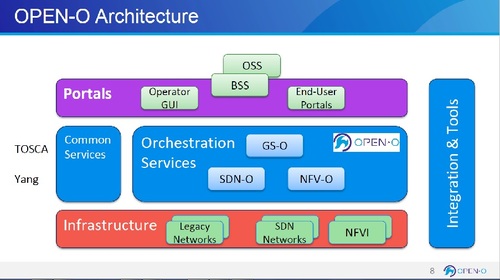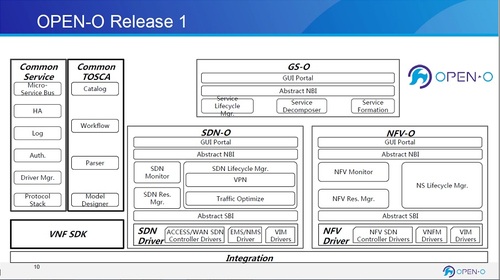OPEN-O Going Beyond the MANO
Open source orchestration effort aiming for broader end-to-end service approach that also addresses brownfield deployments.
October 10, 2016

Among the multiple open source MANO projects, OPEN-O is hoping to distinguish itself for going beyond network management and orchestration to tackle end-to-end service delivery, across both legacy and virtualized networks, its director tells Light Reading.
Marc Cohn also says OPEN-Orchestrator Project (OPEN-O) 's first software release is expected in November or December, about six months after an organizational meeting in June and ten months after the group was announced last February, led by Asian operators China Mobile Communications Corp. , China Telecom Corp. Ltd. (NYSE: CHA) and HKT Ltd. (See OPEN-O Focused on Orchestrating SDN & NFV.)
The organization's ultimate value proposition is "any service over any network," says Cohn, who is a familiar face in the open source community, having been a central figure at the Open Networking Foundation and other groups as a representative from various vendor members, including Ciena Corp. (NYSE: CIEN). He now works for the Linux Foundation , which is supporting OPEN-O.
"We have a very ambitious charter -- it is a charter that goes beyond supporting NFV MANO, which is one of the differences between OPEN-O and other open source MANO groups," Cohn says. "Our objective is to address the brownfield set of applications, because every major carrier has to deal with some legacy technology," and that even applies to some virtualization technology, he notes. "It's not just about open source -- there are [vendor-specific] things, like VMWare, as an example."
Key to that is creating a modular framework that allows for multiple different components to sit both above and below the OPEN-O end-to-end service delivery framework, say Cohn, who'll be a panelist in a discussion of open source efforts at Light Reading's upcoming event, OSS in the Era of SDN & NFV. That includes multiple virtual infrastructure managers, or VIMs, including open source versions such as OpenStack, but also VMWare, or other VIMs needed by specific member projects. It also includes VNF managers, he adds, as well as controllers and network management systems.
Figure 1: 
"We are going to have to be very flexible to adapt this platform into the environment," Cohn says. "So what we did was we created this layer that allows us to integrate with different... we call them components, even though it's hard to think of OpenStack as a component. In a broader more abstract sense it is a component, a very sophisticated one."
That doesn't mean operators will have an infinite choice of components that OPEN-O will support -- at least not out of the box, he hastens to add. That would be impractical.
A couple of things OPEN-O is immediately addressing is a design-time environment, including a graphical user interface, modeling and service catalogs, and portals that enable user interaction.
"In other words, how you actually design a service and do it in such a way that you don't need to create new software to actually realize that service," Cohn explains. "That is what the design-time environment and model-driven automation allows us to do."
The OPEN-O approach is focused on developing a modular framework that allows operators to pick and choose what they want, tailored to their legacy networks, business models or service demands, Cohn says. The design-time environment then allows them to create their own services, in a differentiated fashion, and not rely on vendors to do that for them.
The portals are all about delivering user interfaces, which Cohn says become even more important in the future as operators have to deliver more truly on-demand services that give users genuine control. "In the past, the operator was responsible for that. They may have exposed something, at some level, but it was primarily just a front end to operator processes," he says. "It is the on-demand services we are going to have to address moving forward."
Want to know more about NFV and Open Source strategies? Join us in London for our OSS in the Era of SDN and NFV event here on Light Reading.
OPEN-O is enabling this commonality by being model-driven, Cohn says. And while he admits it would be better for everyone if the industry agreed on common information and data models, as a couple of different initiatives have tried to create, no one is waiting for that to happen. OPEN-O is moving forward using Tosca as its service modeling language and Yang for device modeling.
OPEN-O's first software release, details of which are shown below, will include code for each of the group's initial seven projects. Those projects include a global service orchestrator, an NFV orchestrator, SDN orchestrator, a VNF software development kit API, Common Services, Common TOSCA and integration across the software platform.
Figure 2: 
The organization is already actively engaged in working with other open source groups, including OpenDaylight and Open Platform for NFV Project Inc. , both of which are also under the Linux Foundation banner. But that list also includes the European Telecommunications Standards Institute (ETSI) , to assure it stays aligned with the general NFV framework, the ONF and the MEF , for the latter's Lifecycle Service Orchestration initiative.
OPEN-O also is pursuing a new project, focused on creating a generic VNF manager, and is hoping for broad industry participation in that effort, Cohn says. The idea is to avoid having to create VNF-specific managers, since that smacks of the existing issues around the element management systems needed for each vendor's network elements.
"This is a new project in OPEN-O, to look at this issue in a more systematic way," he says. "We want to reach out to anybody who wants to get in on this, including other open orchestration projects, to work with the VNF community to package up their VNFs in a way to make it easier, no matter whose open orchestrator the operator wants to use."
— Carol Wilson, Editor-at-Large, Light Reading
You May Also Like


_International_Software_Products.jpeg?width=300&auto=webp&quality=80&disable=upscale)







